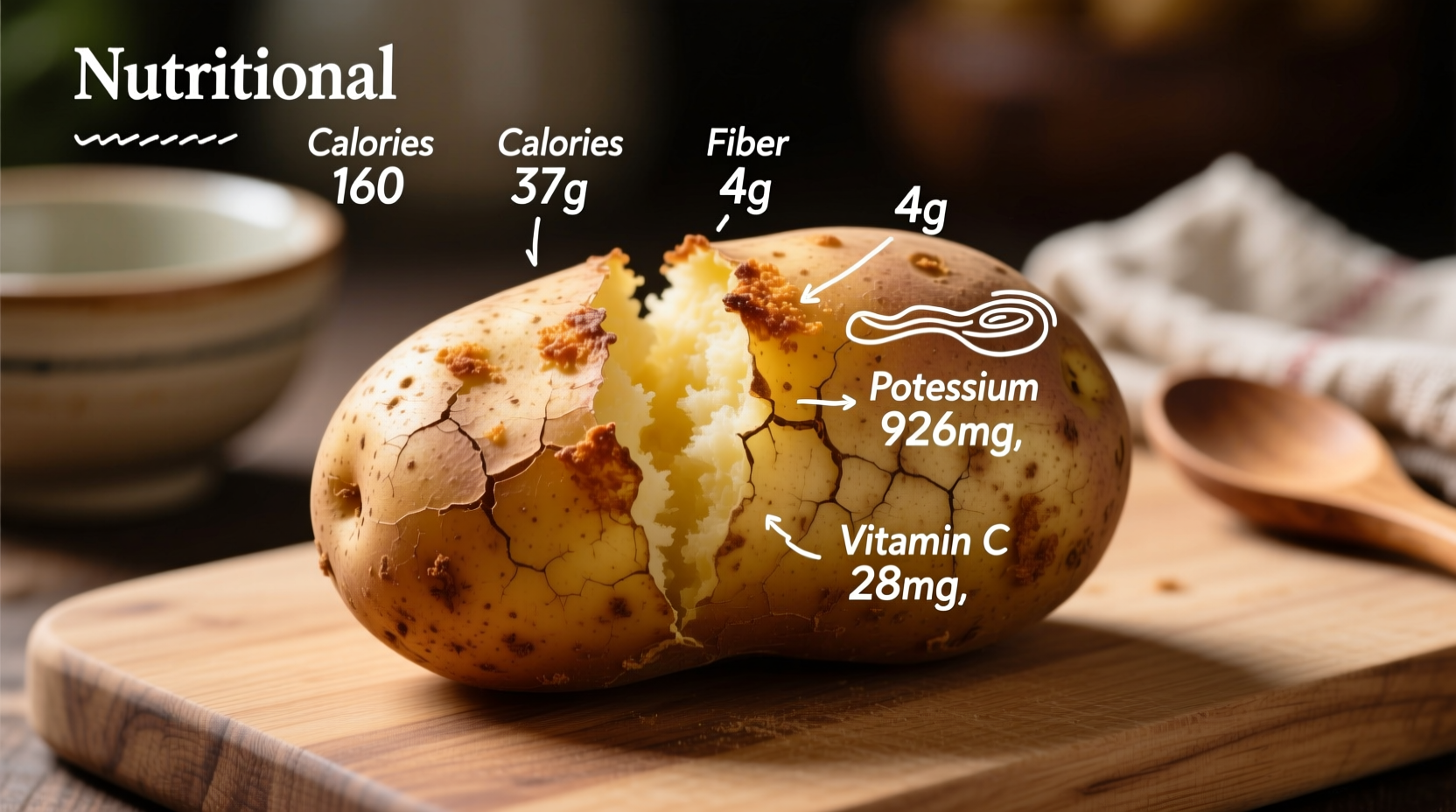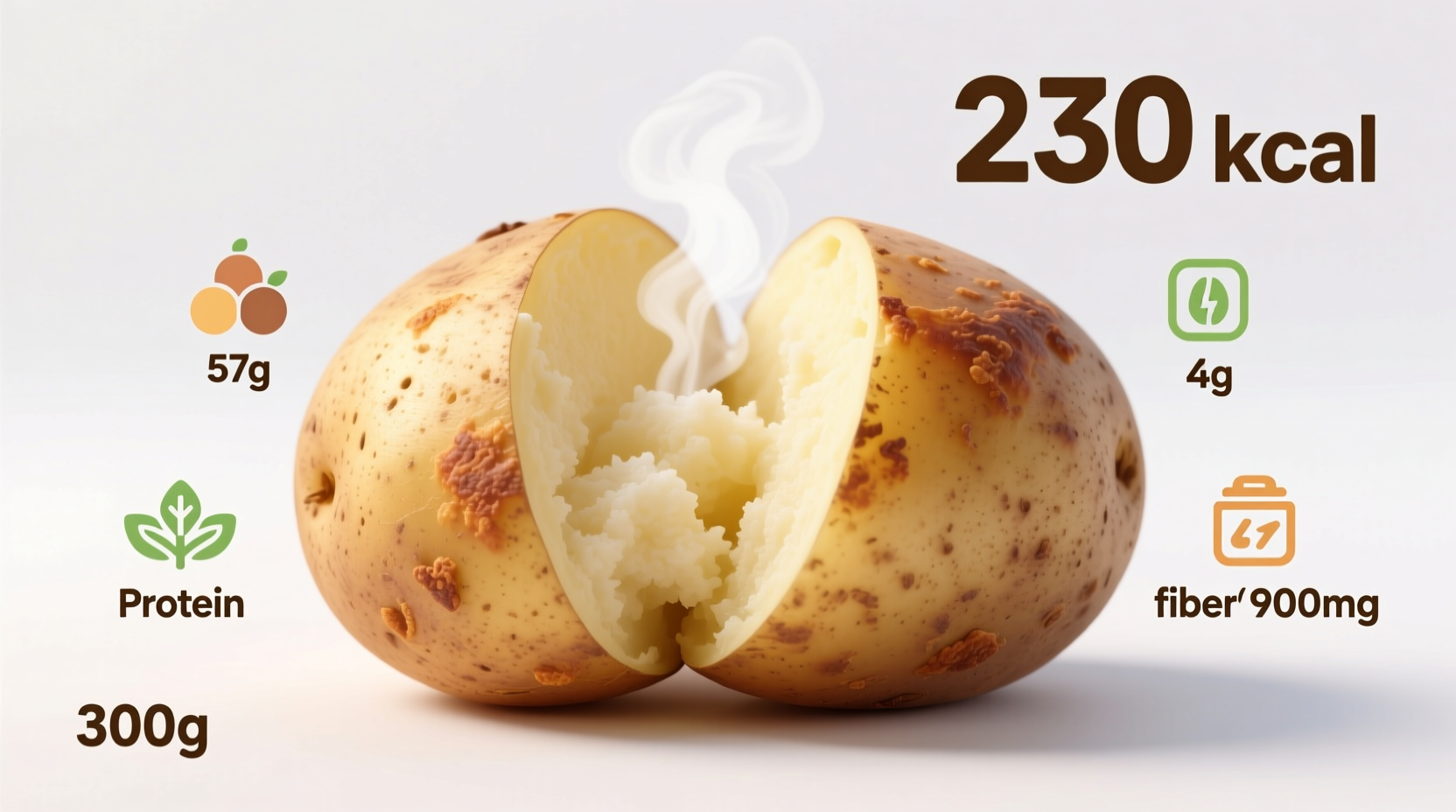Understanding the exact nutritional profile of everyday foods is crucial for making informed dietary choices. Whether you're tracking calories for weight management, managing diabetes, or simply aiming for a balanced diet, knowing what's in your food matters. This comprehensive guide delivers precise, science-backed information about the calorie content and nutritional value of baking potatoes, plus practical tips for incorporating them into various eating plans.
What Exactly Is a "Large" Baking Potato?
Before we dive into nutritional specifics, it's important to clarify portion sizes. According to the USDA's standard measurements:
| Size Category | Raw Weight | Cooked Weight | Diameter |
|---|---|---|---|
| Small | 138g | 77g | 1.5-2.25 inches |
| Medium | 173g | 97g | 2.25-3 inches |
| Large | 300g | 170g | 3-4.25 inches |
| Extra Large | 400g | 225g | 4.25+ inches |
When nutrition labels or diet apps reference a "large" baking potato, they typically mean one weighing approximately 300g raw (about 10.5 ounces) or 170g cooked. This standardization comes from the USDA FoodData Central database, the gold standard for nutritional information in the United States (fdc.nal.usda.gov).
Nutritional Breakdown: Beyond Just Calories
While calorie count matters, the complete nutritional profile determines a food's true value. Here's what you get in a large baked potato with skin:
- Calories: 275
- Carbohydrates: 63g (21% of daily value)
- Fiber: 7g (25% of daily value)
- Protein: 7g
- Fat: 0.4g
- Potassium: 1600mg (46% of daily value)
- Vitamin C: 38mg (42% of daily value)
- Vitamin B6: 0.7mg (41% of daily value)
- Magnesium: 75mg (18% of daily value)
What makes potatoes nutritionally impressive isn't just the numbers—it's how these nutrients work together. The fiber content (concentrated in the skin) slows carbohydrate absorption, preventing blood sugar spikes. The potassium-vitamin C combination supports cardiovascular health while boosting immunity.

How Cooking Method Changes Calorie Content
Many people assume potatoes become higher in calories when cooked, but the reality is more nuanced. The cooking process actually concentrates nutrients as water content decreases:
| Preparation Method | Calories (Large Potato) | Key Nutritional Changes |
|---|---|---|
| Baked with skin | 275 | Maximizes fiber retention; preserves water-soluble vitamins |
| Baked without skin | 250 | Loses 25% of fiber; reduced potassium content |
| Boiled with skin | 240 | Some vitamin C leaches into water; retains most potassium |
| Boiled without skin | 220 | Significant nutrient loss to cooking water |
| Fried (as french fries) | 450+ | Absorbs significant oil; loses water-soluble nutrients |
Research from the Harvard T.H. Chan School of Public Health confirms that preparation method significantly impacts a potato's glycemic response. Baking with skin intact results in a moderate glycemic index (around 60-70), while frying or processing into mashed form with added fats increases both calorie density and glycemic impact (hsph.harvard.edu).
Context Matters: When Potatoes Fit Your Diet Goals
Despite their carbohydrate content, potatoes can be part of various eating patterns when understood in context:
- Weight Management: The high fiber and water content creates significant satiety. Studies show potatoes rank highest on the satiety index—more filling than pasta or rice by weight.
- Diabetes Management: When consumed with protein and healthy fats (like Greek yogurt and olive oil), the glycemic impact decreases substantially.
- Athletic Performance: The complex carbohydrates provide sustained energy release, making potatoes excellent pre-workout fuel.
- Budget-Friendly Nutrition: At approximately $0.25 per large potato, they deliver exceptional nutrient density per dollar.
However, potatoes may not suit every dietary scenario. For low-carb or ketogenic diets, even a single large potato exceeds daily carbohydrate limits. The Academy of Nutrition and Dietetics notes that individuals with insulin resistance should monitor portion sizes and always pair potatoes with protein and fat to moderate blood sugar response (eatright.org).
Smart Ways to Enjoy Baked Potatoes
Maximize nutritional benefits while keeping calories in check with these professional chef techniques:
- Always bake with skin on—this preserves fiber and nutrients while adding texture
- Cool before eating—this increases resistant starch content by up to 30%, improving gut health
- Pair with protein—try Greek yogurt instead of sour cream, or add black beans for plant-based protein
- Add healthy fats—a teaspoon of olive oil enhances nutrient absorption of fat-soluble vitamins
- Season creatively—try nutritional yeast for B vitamins instead of excessive salt
Professional chefs like those at the Culinary Institute of America emphasize that the cooking and cooling process transforms some potato starch into resistant starch—a prebiotic fiber that feeds beneficial gut bacteria. This simple technique, documented in the Journal of Nutrition, can reduce the glycemic impact by 20-25% while boosting digestive health benefits.
Potatoes vs. Alternatives: Making Informed Choices
How does a baked potato compare to other common carbohydrate sources?
| Food (170g cooked) | Calories | Carbs | Fiber | Protein | Key Advantages |
|---|---|---|---|---|---|
| Baking potato | 275 | 63g | 7g | 7g | Highest potassium; versatile preparation |
| Sweet potato | 210 | 50g | 6g | 4g | Higher vitamin A; lower glycemic index |
| Quinoa | 220 | 39g | 5g | 8g | Complete protein; gluten-free |
| Brown rice | 190 | 41g | 3g | 4g | Lower glycemic impact; widely available |
Each option has unique benefits—the best choice depends on your specific nutritional goals and health considerations. For athletes needing quick energy, potatoes provide excellent carbohydrate density. For those managing blood sugar, sweet potatoes offer a slightly lower glycemic profile.
Practical Application: Building Balanced Meals
Here's how to incorporate a large baked potato into different dietary patterns:
- Weight Loss Plate: Half potato (135 calories), 3oz grilled chicken, large portion of roasted broccoli
- Vegetarian Power Meal: Whole potato topped with ½ cup black beans, salsa, and avocado slices
- Post-Workout Recovery: Potato with 2 scrambled eggs and spinach for protein-carb synergy
- Diabetes-Friendly: Small potato (⅔ of large) with 3oz salmon and asparagus
Dietitians at the Mayo Clinic emphasize that the context of the entire meal matters more than any single food. Pairing potatoes with protein and non-starchy vegetables creates balanced nutrition that supports various health goals (mayoclinic.org).
Frequently Asked Questions
Does the skin of a baked potato contain most of the nutrients?
Yes, the skin contains approximately 50% of the potato's total dietary fiber and significant amounts of potassium, iron, and B vitamins. Removing the skin reduces fiber content by about 25% and decreases overall nutrient density. Always bake potatoes with skin intact for maximum nutritional benefit.
Are baked potatoes good for weight loss?
Baked potatoes can support weight loss when consumed in appropriate portions and prepared healthily. Their high fiber and water content create significant satiety—potatoes rank highest on the satiety index compared to other common carbohydrate sources. A large baked potato contains only 275 calories but keeps you feeling full longer than many lower-calorie processed foods.
How do cooling potatoes affect their nutritional value?
Cooling cooked potatoes increases their resistant starch content by up to 30%. This transformation turns some digestible starch into a prebiotic fiber that feeds beneficial gut bacteria, reduces the glycemic impact by 20-25%, and provides additional digestive health benefits. For maximum benefit, bake potatoes, then refrigerate for 24 hours before eating cold or reheating.
Can people with diabetes eat baked potatoes?
Yes, but portion control and preparation matter. People with diabetes should consume potatoes in moderate portions (typically ½ to ⅔ of a large potato), always with the skin, and pair them with protein and healthy fats to moderate blood sugar response. Cooling potatoes before eating increases resistant starch, which further reduces glycemic impact. Monitoring individual blood sugar response is recommended.
How does the calorie count change if I add toppings to my baked potato?
Toppings significantly impact total calories. Two tablespoons of sour cream adds 50 calories, while the same amount of Greek yogurt adds only 20. A tablespoon of butter adds 100 calories, whereas olive oil adds 120 but with healthier fats. Bacon bits (2 tablespoons) contribute 45 calories, and cheddar cheese (¼ cup) adds 110. For lowest calorie options, try salsa, steamed broccoli, or herbs.











 浙公网安备
33010002000092号
浙公网安备
33010002000092号 浙B2-20120091-4
浙B2-20120091-4